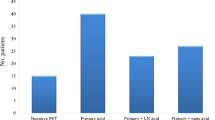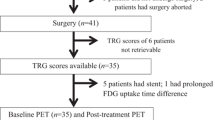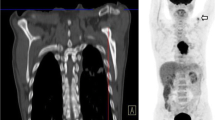Abstract
Purpose
The aim of the study was to compare the pre-operative metabolic tumour length on FDG PET/CT with the resected pathological specimen in patients with oesophageal cancer.
Methods
All patients diagnosed with oesophageal carcinoma who had undergone staging PET/CT imaging between the period of June 2002 and May 2008 who were then suitable for curative surgery, either with or without neo-adjuvant chemotherapy, were included in this study. Metabolic tumour length was assessed using both visual analysis and a maximum standardised uptake value (SUVmax) cutoff of 2.5.
Results
Thirty-nine patients proceeded directly to curative surgical resection, whereas 48 patients received neo-adjuvant chemotherapy, followed by curative surgery. The 95% limits of agreement in the surgical arm were more accurate when the metabolic tumour length was visually assessed with a mean difference of −0.05 cm (SD 2.16 cm) compared to a mean difference of +2.42 cm (SD 3.46 cm) when assessed with an SUVmax cutoff of 2.5. In the neo-adjuvant group, the 95% limits of agreement were once again more accurate when assessed visually with a mean difference of −0.6 cm (SD 1.84 cm) compared to a mean difference of +1.58 cm (SD 3.1 cm) when assessed with an SUVmax cutoff of 2.5.
Conclusion
This study confirms the high accuracy of PET/CT in measuring gross target volume (GTV) length. A visual method for GTV length measurement was demonstrated to be superior and more accurate than when using an SUVmax cutoff of 2.5. This has the potential of reducing the planning target volume with dose escalation to the tumour with a corresponding reduction in normal tissue complication probability.





Similar content being viewed by others
References
Office of National Statistics. Mortality statistics: cause, England and Wales 2007. London TSO 2009
Northern Ireland Cancer Registry. Cancer mortality in Northern Ireland 2007
ISD Online 2009. Cancer mortality in Scotland 2007
Thomas P, Doddoli C, Lienne P, Morati N, Thirion X, Garbe L, et al. Changing patterns and surgical results in adenocarcinoma of the oesophagus. Br J Surg 1997;84(1):119–25.
Eloubeidi MA, Desmond R, Arguedas MR, Reed CE, Wilcox CM. Prognostic factors for the survival of patients with esophageal carcinoma in the U.S.: the importance of tumor length and lymph node status. Cancer 2002;95(7):1434–43.
Griffiths EA, Brummell Z, Gorthi G, Pritchard SA, Welch IM. Tumor length as a prognostic factor in esophageal malignancy: univariate and multivariate survival analyses. J Surg Oncol 2006;93(4):258–67.
Kato H, Kuwano H, Nakajima M, Miyazaki T, Yoshikawa M, Ojima H, et al. Comparison between positron emission tomography and computed tomography in the use of the assessment of esophageal carcinoma. Cancer 2002;94(4):921–8.
Mac Manus MP, Hicks RJ, Ball DL, Kalff V, Matthews JP, Salminen E, et al. F-18 fluorodeoxyglucose positron emission tomography staging in radical radiotherapy candidates with nonsmall cell lung carcinoma: powerful correlation with survival and high impact on treatment. Cancer 2001;92(4):886–95.
Mah K, Caldwell CB, Ung YC, Danjoux CE, Balogh JM, Ganguli SN, et al. The impact of (18)FDG-PET on target and critical organs in CT-based treatment planning of patients with poorly defined non-small-cell lung carcinoma: a prospective study. Int J Radiat Oncol Biol Phys 2002;52(2):339–50.
Bradley J, Thorstad WL, Mutic S, Miller TR, Dehdashti F, Siegel BA, et al. Impact of FDG-PET on radiation therapy volume delineation in non-small-cell lung cancer. Int J Radiat Oncol Biol Phys 2004;59(1):78–86.
Morota M, Gomi K, Kozuka T, Chin K, Matsuura M, Oguchi M, et al. Late toxicity after definitive concurrent chemoradiotherapy for thoracic esophageal carcinoma. Int J Radiat Oncol Biol Phys 2009;75(1):122–8.
Marks LB, Yu X, Vujaskovic Z, Small Jr W, Folz R, Anscher MS. Radiation-induced lung injury. Semin Radiat Oncol 2003;13(3):333–45.
Gagliardi G, Lax I, Rutqvist LE. Partial irradiation of the heart. Semin Radiat Oncol 2001;11(3):224–33.
Daisne JF, Duprez T, Weynand B, Lonneux M, Hamoir M, Reychler H, et al. Tumor volume in pharyngolaryngeal squamous cell carcinoma: comparison at CT, MR imaging, and FDG PET and validation with surgical specimen. Radiology 2004;233(1):93–100.
Kiffer JD, Berlangieri SU, Scott AM, Quong G, Feigen M, Schumer W, et al. The contribution of 18F-fluoro-2-deoxy-glucose positron emission tomographic imaging to radiotherapy planning in lung cancer. Lung Cancer 1998;19(3):167–77.
Leong T, Everitt C, Yuen K, Condron S, Hui A, Ngan SY, et al. A prospective study to evaluate the impact of FDG-PET on CT-based radiotherapy treatment planning for oesophageal cancer. Radiother Oncol 2006;78(3):254–61.
Zhong X, Yu J, Zhang B, Mu D, Zhang W, Li D, et al. Using 18F-fluorodeoxyglucose positron emission tomography to estimate the length of gross tumor in patients with squamous cell carcinoma of the esophagus. Int J Radiat Oncol Biol Phys 2009;73(1):136–41.
Mamede M, El Fakhri G, Abreu-e-Lima P, Gandler W, Nosé V, Gerbaudo VH. Pre-operative estimation of esophageal tumor metabolic length in FDG-PET images with surgical pathology confirmation. Ann Nucl Med 2007;21(10):553–62.
Han D, Yu J, Yu Y, Zhang G, Zhong X, Lu J, et al. Comparison of (18)F-fluorothymidine and (18)F-fluorodeoxyglucose PET/CT in delineating gross tumor volume by optimal threshold in patients with squamous cell carcinoma of thoracic esophagus. Int J Radiat Oncol Biol Phys 2010;76(4):1235–41.
Bland JM, Altman DG. Statistical methods for assessing agreement between two methods of clinical measurement. Lancet 1986;1(8476):307–10.
Sun DR. Ten-year follow-up of esophageal cancer treated by radical radiation therapy: analysis of 869 patients. Int J Radiat Oncol Biol Phys 1989;16(2):329–34.
Newaishy GA, Read GA, Duncan W, Kerr GR. Results of radical radiotherapy of squamous cell carcinoma of the oesophagus. Clin Radiol 1982;33(3):347–52.
Okawa T, Kita M, Tanaka M, Ikeda M. Results of radiotherapy for inoperable locally advanced esophageal cancer. Int J Radiat Oncol Biol Phys 1989;17(1):49–54.
Hong TS, Killoran JH, Mamede M, Mamon HJ. Impact of manual and automated interpretation of fused PET/CT data on esophageal target definitions in radiation planning. Int J Radiat Oncol Biol Phys 2008;72(5):1612–8.
Erdi YE, Macapinlac H, Rosenzweig KE, Humm JL, Larson SM, Erdi AK, et al. Use of PET to monitor the response of lung cancer to radiation treatment. Eur J Nucl Med 2000;27(7):861–6.
Mac Manus MP, Hicks RJ, Matthews JP, McKenzie A, Rischin D, Salminen EK, et al. Positron emission tomography is superior to computed tomography scanning for response-assessment after radical radiotherapy or chemoradiotherapy in patients with non-small-cell lung cancer. J Clin Oncol 2003;21(7):1285–92.
Yao M, Graham MM, Hoffman HT, Smith RB, Funk GF, Graham SM, et al. The role of post-radiation therapy FDG PET in prediction of necessity for post-radiation therapy neck dissection in locally advanced head-and-neck squamous cell carcinoma. Int J Radiat Oncol Biol Phys 2004;59(4):1001–10.
Roedl JB, Sahani DV, Colen RR, Fischman AJ, Mueller PR, Blake MA. Tumour length measured on PET-CT predicts the most appropriate stage-dependent therapeutic approach in oesophageal cancer. Eur Radiol 2008;18(12):2833–40.
van Baardwijk A, Baumert BG, Bosmans G, van Kroonenburgh M, Stroobants S, Gregoire V, et al. The current status of FDG-PET in tumour volume definition in radiotherapy treatment planning. Cancer Treat Rev 2006;32(4):245–60.
Konski A, Doss M, Milestone B, Haluszka O, Hanlon A, Freedman G, et al. The integration of 18-fluoro-deoxy-glucose positron emission tomography and endoscopic ultrasound in the treatment-planning process for esophageal carcinoma. Int J Radiat Oncol Biol Phys 2005;61(4):1123–8.
Siu KF, Cheung HC, Wong J. Shrinkage of the esophagus after resection for carcinoma. Ann Surg 1986;203(2):173–6.
Vrieze O, Haustermans K, De Wever W, Lerut T, Van Cutsem E, Ectors N, et al. Is there a role for FGD-PET in radiotherapy planning in esophageal carcinoma? Radiother Oncol 2004;73(3):269–75.
Gondi V, Bradley K, Mehta M, Howard A, Khuntia D, Ritter M, et al. Impact of hybrid fluorodeoxyglucose positron-emission tomography/computed tomography on radiotherapy planning in esophageal and non-small-cell lung cancer. Int J Radiat Oncol Biol Phys 2007;67(1):187–95.
Vesprini D, Ung Y, Dinniwell R, Breen S, Cheung F, Grabarz D, et al. Improving observer variability in target delineation for gastro-oesophageal cancer—the role of (18F)fluoro-2-deoxy-D-glucose positron emission tomography/computed tomography. Clin Oncol R Coll Radiol 2008;20(8):631–8.
Moureau-Zabotto L, Touboul E, Lerouge D, Deniaud-Alexandre E, Grahek D, Foulquier JN, et al. Impact of CT and 18F-deoxyglucose positron emission tomography image fusion for conformal radiotherapy in esophageal carcinoma. Int J Radiat Oncol Biol Phys 2005;63(2):340–5.
Acknowledgments
The authors would like to thank Dr Richard Davies [Consultant Pathologist, Department of Pathology, Royal Victoria Hospital, Belfast], Paula Todd [Chief Nuclear Medicine Technologist, Nuclear Medicine Department, Imaging Centre, Royal Victoria Hospital, Belfast] and Christopher Cardwell [Statistician, Centre for Public Health, Queens University Belfast] for their support on this project.
Conflicts of interest
None.
Author information
Authors and Affiliations
Corresponding author
Rights and permissions
About this article
Cite this article
Jeganathan, R., McGuigan, J., Campbell, F. et al. Does pre-operative estimation of oesophageal tumour metabolic length using 18F-fluorodeoxyglucose PET/CT images compare with surgical pathology length?. Eur J Nucl Med Mol Imaging 38, 656–662 (2011). https://doi.org/10.1007/s00259-010-1670-3
Received:
Accepted:
Published:
Issue Date:
DOI: https://doi.org/10.1007/s00259-010-1670-3




